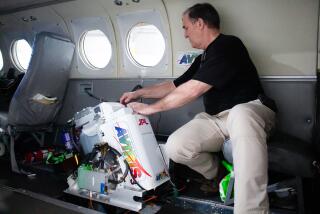New NASA mission will allow scientists to track rising seas from space
- Share via
Scientists at NASA’s Jet Propulsion Laboratory are teaming up with European researchers to launch a mission that will probe the oceans’ depths over the next decade — and chart their inexorable rise.
The Sentinel-6/Jason-CS mission builds on four previous satellites that have circled the globe along the same path since 1992, carefully documenting the millimeter-by-millimeter changes in sea level fueled by greenhouse gas emissions. Over that time, they have found that the world’s oceans are rising at an increasingly rapid rate.
The rising waters have had some disastrous consequences, including the erosion of precious coastlines, contamination of agricultural land, more frequent and destructive high tides, and lost habitat for both humans and wildlife.
The Jason satellites, coupled with complementary readings from other NASA Earth-facing missions, have been essential to tracking these changes and dealing with their consequences, said R. Steven Nerem, a professor of aerospace engineering sciences at the University of Colorado Boulder and member of NASA’s Ocean Surface Topography Science Team.
“Without the satellites we’d be blind,” said Nerem, who has tracked sea level rise and its causes for decades. “It’s just very critical that we continue these missions because it’s the way we understand what’s going on.”
Earth’s oceans have swelled and shrunk for eons, but they’ve typically done so very gradually, rather than at the breakneck pace being recorded today.
Recent readings put the rate at roughly 4.5 millimeters per year, up from about 3 millimeters per year in 2005 and around 2 millimeters per year in 1993. Add it all up and the seas are now about 3 inches higher, on average, than they were a quarter-century ago.
The question the new Sentinel-6/Jason-CS mission will seek to answer is this: How much faster will the seas rise in the coming decade? And what will happen to Earth beyond then?
“Hundreds of millions of people around the Earth will be affected by sea level rise in the next 50 to 100 years, and our ability to measure how much of that is human-caused is really rooted in these satellites,” said JPL climate scientist Josh Willis, NASA’s project scientist for Jason-CS.
Since the dawn of the industrial age, humans have been emitting excess amounts of carbon dioxide and other heat-trapping gases, causing Earth’s temperature to rise. Melting glaciers have added water to the oceans. The additional heat also causes water to expand, pushing sea levels up even higher.
Altogether, the oceans have absorbed more than 90% of the extra heat trapped by greenhouse gases, Willis said.
And since they cover more than two-thirds of Earth’s surface, the oceans are reshaping the planet.
“The oceans, in a really big way, are kind of our most important indicator of just how much humans have changed the climate since the start of the industrial revolution,” Willis said.
From an orbit 830 miles above Earth, Sentinel-6/Jason-CS will scan 95% of the planet’s ice-free oceans, gathering a new set of global data every 10 days. Its altimeter will bounce a radar signal off the water’s surface, measuring the time it takes for the signal to return and using that information to calculate the ocean’s height.
Other instruments will hone those readings by compensating for the atmosphere’s effect on the timing of these radar signals, and by helping keep track of the spacecraft’s precise position.
Beyond average sea level, the radar readings will provide a wealth of additional information for researchers, who can use them to determine heat changes in the upper ocean, the flow of ocean currents, wave heights and the speed of wind over the water.
The data may even shed light on much of the still-mysterious topography of the sea floor, said Eric Leuliette, the Jason program and project scientist for the National Oceanic and Atmospheric Administration.
“As my colleagues here often point out, we’ve mapped Venus, the moon and Mars better than we’ve mapped the bottom of the ocean,” he said.
Jason data hits the ground running, Leuliette said. Within hours, it’s sent out to National Weather Service forecasters, whose predictions are used by ships for navigation and other maritime purposes. Within a day, it goes into models that help meteorologists make better predictions about large weather events. For example, the information Jason gathers on how much heat is stored beneath the ocean surface can help in forecasting the intensity of a hurricane, or the strength of an El Niño event.
Sentinel-6/Jason-CS is part of an international collaboration involving NASA, NOAA, the European Space Agency, the European Organization for the Exploitation of Meteorological Satellites (EUMETSAT) and France’s National Center for Space Studies (CNES).
The spacecraft will fly in the same orbit as its predecessors, to ensure an unbroken line of sea level readings. That consistency is key for predicting future sea level rise — and preparing for its consequences, Willis said.
Unlike prior missions, which involved only a single spacecraft, this one will employ two satellites, each with a primary mission of five years, said Parag Vaze, Jason’s project manager at JPL. The first is scheduled to launch from Vandenberg Air Force Base in California in November, and the second will follow in 2025, making it the most long-lived of the Jason missions to date.
Sentinel-6/Jason-CS will also meet a different end than its forebears, Vaze said.
In an effort to reduce the accumulation of space junk, the two satellites will be the first in the Jason line to execute a planned de-orbit once they complete their final tasks. Even as the older satellites continue to circle the globe, their younger brethren will burn up in the atmosphere as they plunge back toward Earth.







